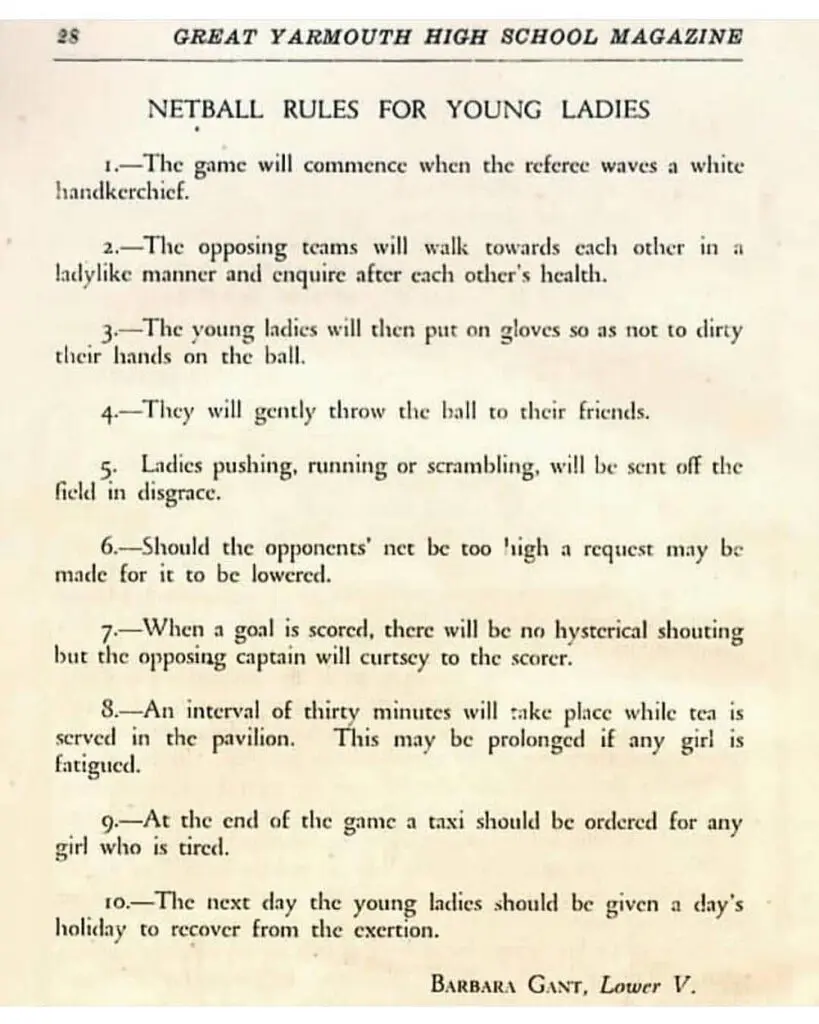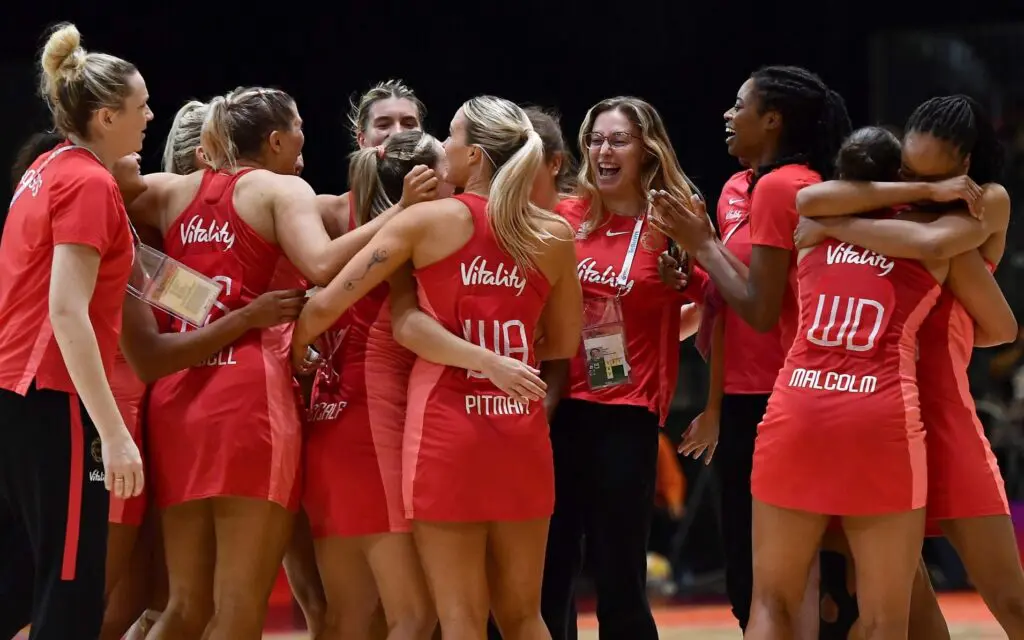The history of Netball is fascinating! The game of Netball can loosely be dated back to the 1890s after basketball was invented by James Naismith to entertain a group of 18 young men at the School for Christian Workers, the now ‘YMCA’. There were 9 players per team, 3 guards, 3 centres and 3 forwards, simply because there was 18 youths to entertain that day!
During the testing of James Naismith’s new game of ‘Basketball’, it was fast discovered that the competitive nature of the previous goal system resulted in too many injuries with players fighting to score points. It was then decided that the goals would be in the form of hoops standing over 3m from the ground, ensuring time to regain composure and so technique could be applied, slowing the game down and trying to eliminate the risk of incidents.
Basketball took off quickly, and just two days after the initial invention a few local gym teachers liked the look of the game and started teaching it to their female pupils too! Although first designed for men, in 1892 it was adapted for female students and the new modified version of basketball had become very popular amongst ladies and spread in different forms around the United States. In 1895, after hearing about this new sport that had got everybody talking, Clara Baer, a sports teacher from New Orleans, wrote to James Naismith to ask for a copy of the rules for Basketball. After receiving the rules and the court drawings, Clara misunderstood the court layout and interpreted the areas as boundaries and assumed that the players were not allowed to leave those areas! The game of Netball hadn’t yet been invented, but the basis was starting to take shape due to this small mistake!
 Netball in England
Netball in England
The hybrid game of Basketball/Netball had gained a huge popularity in the USA quite quickly and a version was taken over the pond to England just before 1900. The change from Basketball to Netball can be traced to Dartford in England at Madame Osterberg’s College in 1897. An American teacher introduced a new game, using Basketball rules and outdoor courts, but removing the backboards for netted hoops.
This variant of the game was designed specifically for women, due to their ‘lack of physical capabilities’ and to maintain the social etiquette of the time. This was to ensure that women could remain ‘dignified’ and wouldn’t end in over-exertion, which is why prolonged breaks during the match included tea and cakes in order to prevent ‘fainting’ and exhaustion amongst the women.
‘Women’s Basketball’ to ‘Net Ball’
To begin with, there were many variations within the rules, including differing opinions on amount of players, different positions, and 3-bounce dribbling (which eventually ceased to exist), and the name for this new sport started to settle on ‘Net Ball’ due to the new way to score goals. When it became obvious that it was now a completely different sport to Basketball, a lot of effort was then made to standardise the rules, with the first official Netball governing body forming in 1926 – The All England Netball Association, and the rules were published by the Women’s Basketball Association (WBA) the same year.
First International games of Netball

The rules were still evolving and being refined but that didn’t stop the first international games of Netball being played! The initial stages of international netball competition faced obstacles due to variations in rules across different countries. A significant milestone in this journey occurred in 1938 when Australia and New Zealand, where netball was still referred to as “women’s basketball,” engaged in their first international match. This event took place during New Zealand’s tour of Australia, where they competed against local and state teams, as well as the Australian national team.
At that time, Australia played seven-a-side netball, while New Zealand played nine-a-side. Seven-a-side rules were adopted for this meet, incorporating certain netball rules from England into their gameplay. During this historic encounter, Australia’s national team emerged victorious, defeating New Zealand with a score of 40–11.
England ventured into international netball competition in 1949, facing off against Scotland and Wales in their first-ever international “netball” matches. In both games, England emerged triumphant with a final score of 25–3. These pivotal moments marked the beginning of a global journey for netball as it gradually gained recognition and standardised rules across various countries.
Global standardisation of Netball
With there being so many variations of the rules still being played all around the world, it wasn’t until an Australian tour to England in 1957 that discussions finally took place concerning a complete standardisation of the rules across the world. This lead to the representatives from England, Australia, New Zealand, South Africa and the West Indies meeting in Sri Lanka, establishing The International Federation for Women’s Basketball and Netball. The rules were formalised and it was decided that there would be World Championships held every 4 years, much like the Football World Cup and the Olympics Championships, beginning in England in 1963.
Despite gaining huge popularity within the commonwealth countries since it’s inception in 1890s, it wasn’t until 1998 when netball was introduced to the Commonwealth Games Programme – with Australia taking the Gold, New Zealand the Silver, and England the Bronze! (Of course it was these countries!)
Netball at the Olympics
Women were first able to compete in the Olympic Games in 1900 in 3 events, tennis, croquet and golf, with women’s basketball entering the Games in 1976. Now, in 2023, leading up to the 2024 Paris Olympics, Netball still remains unrecognised as an Olympic sport, despite being officially recognised by the IOC (International Olympic Committee) in 1995 after 20 years of campaigning! The absence of netball from the Olympic Games is viewed by the netball community as a significant obstacle to the sport’s worldwide expansion, resulting in a lack of media exposure and financial support. To be included in the Olympics Programme, a sport must have widespread global participation, this means that the sport must be played by men in at least 75 countries, and by women in at least 40 countries.
Historically in society, a higher number of male athletes will receive more financial backing than their female counterparts, as they are perceived to have greater opportunities to achieve success at the highest competitive levels than women. The media often under-represents female team-sports in comparison to male team-sports, with any men’s event receiving greater coverage, more funding and TV audiences, not to mention being house-hold names for almost every sports team or event! For women, the media focus their attention on their individual sports rather than women’s team sports, which is why we hear more about female swimmers, track & field stars, cyclists, gymnasts and rowers than we do about the Olympic ladies football, cricket, lacrosse and rugby 7s teams.
Nevertheless, the IOC’s recognition of netball’s federation in 1995 has opened up previously inaccessible funding sources for the global netball community. These sources include the IOC itself, national Olympic committees and sports organisations, as well as countries governing bodies.
2023 and beyond

As it stands, after 130 years of the sport’s creation, recognition with the IOC, hundreds of semi-professional and professional netball clubs and competitions worldwide, the technology advances made from the early 2000s, Netball World Cups and the Commonwealth Games, not to mention over 20,000 players playing weekly in our Play Netball leagues, the sport is still not where it deserves to be! With the Roses success at the 2023 Netball World Cup inspiring the next generation of netball-lovers, we firmly believe that the funding, exposure and Olympic dreams for netball is just a short time away!
Ready to play netball with us? You can find your nearest league by typing in your city or postcode in our ‘find your nearest league’ search bar at the top of our website.
Useful links!
Find out more about our leagues
What Netball position are you?
Visit our Play 5-a-Side website!
Visit our Play Hockey website!
